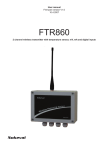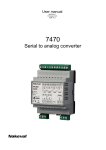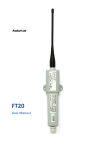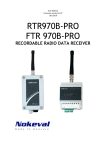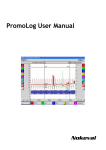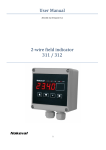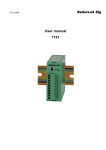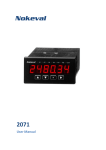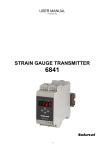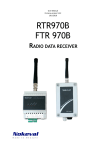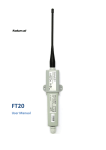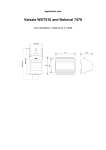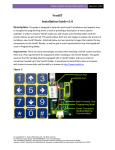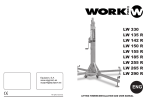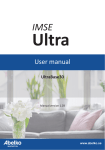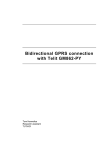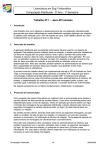Download Serial to analog converter
Transcript
User manual 22.1.2007 V2.0 7470 Serial to analog converter INTRODUCTION 7470 is a serial-bus controlled analog output unit. It provides four mA or V outputs, that can be controlled via an RS-232 or RS-485 bus. As a slave, it supports Nokeval SCL, Modbus RTU, and Ascii protocols. Alternatively, it can function as a SCL Master querying other devices. Analog output ranges include 0-20mA, 4-20mA, 05V, and 0-10V. 7470 needs 24 VDC supply voltage. The analog outputs are not galvanically isolated from the power supply or each other. They share the common negative wire. However the serial bus is galvanically isolated. How to use this manual The chapter General shows how to mount and connect this device. It also tells how to access the configuration settings. The settings itself are described in chapter Configuration menu. Each of the available serial modes are described in the chapters of their own. Table of contents Introduction.........................................................................................................................................................2 General...............................................................................................................................................................3 Configuration menu............................................................................................................................................5 SCL protocol.......................................................................................................................................................7 Modbus protocol.................................................................................................................................................8 Ascii mode........................................................................................................................................................10 SCL Master.......................................................................................................................................................12 Metso Hart........................................................................................................................................................14 Nopsa................................................................................................................................................................15 Specifications....................................................................................................................................................16 Manufacturer Tel +358 3 3424800 Fax +358 3 3422066 WWW: www.nokeval.com Nokeval Oy Yrittäjäkatu 12 FIN-37100 Nokia Finland 2 GENERAL Mounting This transmitter is intended to be mounted on a 35 mm DIN rail. Connections RS-485 RS-232 Supply voltage 24 VDC D1 (A+) D0 (B-) Com RX Com TX + 1 2 3 4 5 6 7 8 9 10 11 12 13 + mA 14 - Com 15 +V 16 + mA 17 18 - Com +V 19 + mA 20 21 - Com +V 22 + mA 23 - Com 24 +V Output 1 (Ch1) Output 2 (Ch2) Output 3 (Ch3) Output 4 (Ch4) The green connector blocks are detachable to make connecting easier. They accept up to 2.5mm2 wires. Jumpers J1 J1 J2 Jumper J1 should be normally open. It is closed when the 7470 baud rate is not known, to force 9600 baud. J2 Baud rate configured on menu settings Baudrate fixed to 9600baud RS-485 Non-terminated RS-485 Terminated To access the jumpers, the enclosure has to be opened. Detach the converter from the DIN rail and insert a small flat-bladed screwdriver between the top (grey) and bottom (black) parts of the enclosure at each side and pull the top part off. Jumper J2 engages the RS-485 termination. It should be closed if this device is the last on the bus, otherwise open. 3 Configuring The 7470 can be configured with a PC or with a hand-held programmer. will also change the baud rate to 9600 and make the 7470 to respond in any bus address. The plug may be the plug of the programming cable, or any 3.5mm mono plug. When the plug is pulled off, 7470 will start using the protocol defined in the configuration menu. PC configuration The configuration settings are accessed with a software called MekuWin, available free of charge. The configuration menu contents are described in the chapter Configuration menu. How to use MekuWin, see its manual. The configuration settings may be accessed via the RS-232 or RS-485 buses or via the 3.5mm "POL" connector on the front panel. Hand-held programmer To use the POL connector, use a POL-RS232 cable or DCS772 USB-to-POL cable. An alternative to the PC programming is to use a hand-held programmer 6790. It is plugged to the POL connector on the 7470 front panel. The menu contents are described in the chapter Configuration menu. How to use 6790, see its manual. When the 7470 is configured for SCL (slave) mode, it can be accessed via any port straight away. This is the factory default. In other modes than SCL (slave), a plug has to be plugged to the POL connector on the front panel to revert the 7470 to the SCL (slave) mode. The plug Note: 6790 is not able to edit string type settings, so it can not be used to edit the custom Ascii parser configuration string. 4 CONFIGURATION MENU Conf Ch 1 Fetch Ch 1 From Groups Ch 2 Range 1 Ch 3 Lo 2 Addr Ch 4 Hi 3 First Limit 4 Num Ser Ser Mode 5 Baud 6 Parity 7 Addr 8 Parser Put String Groups Stime 1 DelayResp Master 1 Master Fetch Put 1 2 From 3 Addr 4 First 5 Num 6 7 8 The menu is arranged hierarchically. The first level contains four submenus, one for each analog output, and a serial communications submenu. Some of the settings are hidden when they are not used. Ch submenus Serial bus OUT CH 1 100 Analog output Internal channels 4-20mA From=1 1 = 100 2 = 23.4 3 = -10.9 4 = 0.0 Each analog output is configured independently. Range The analog output range selection. Options are: • 0-20mA • 4-20mA • 0-5V • 0-10V From 7470 contains 32 internal channels storing the variable values sent via a serial bus. The channels are numbered 1…32. The From setting is used to select, which internal channel is used to control this analog output. Lo, Hi Most often the values are sent to internal channels 1…4, and the first analog output channel follows the first internal channel etc. However, some times it may be useful to be able to have several analog outputs following the same internal channel. Analog output scaling. When the channel value controlling the analog output corresponds to the Lo setting, the output will give its low end signal (e.g. 5 4 mA if the range is 4-20mA). Likewise, the value of Hi will give the high end signal. points, e.g. the 4-20mA output will not go below 4 mA nor above 20 mA even if requested to. Limit If the safety timer expires, the output will go to 0 mA or 0 V despite of this setting. Limits the analog output within the nominal range. If enabled, the analog output will not exceed its end Ser submenu • In Modbus mode, legal values are 1…247. • In HART mode, legal values are 0…127. Mode Serial bus protocol and mode. • SCL (slave): Nokeval SCL protocol. 7470 may be controlled using SCL commands, like OUT CH and OUT SCAN. See chapter SCL protocol. • Modbus: Modbus RTU protocol. 7470 may be controlled using "write holding register" and "write multiple registers" functions. All the configuration settings are also accessible. See chapter Modbus protocol. • Ascii: 7470 accepts simple messages with no proprietary protocol. The messages has to end with cr, lf, or both. See chapter Ascii mode. • SCL Master: 7470 acts as a serial bus master, sending commands to the other devices on the bus. Only one device should be a master on a single bus. In this mode, 7470 can read serial bus transmitters and Nokeval RTR970PRO radio receiver without a PC or another master. See chapter SCL Master. • Metso HART: Hart-style protocol. See chapter Metso HART. Parser Parser selection in Ascii mode. Options are: • Classic: Non-configurable parser, equivalent to 7470 firmware versions 1.x. • Custom: Configurable parser. See chapter Ascii mode. String Parser configuration string in Ascii mode, when Custom parser is selected. See chapter Ascii mode. Stime Baud Safety timer. Defines a safety time in seconds. If some of the internal channels (see Ch\From on page 5) is not refreshed within this time, the safety timer will expire on that channel. An analog output configured to follow that channel will then go low (0 V or mA). This works in every mode. Baud rate 300…19200. All the devices on the bus must have the same baud rate. Factory default is 9600. The time can be selected from 1 to 60 seconds in 1 second steps. To disable the safety timers, set value of 0 here. Parity DelayResp Applicable for Modbus only. Options: • 8N2 • 8E1 (recommended, factory default) • 8O1 Applies to SCL (slave) mode only. When some other device sends a SCL command to the 7470, it will process the command and send a response as soon as possible, but not earlier than 3.5 characters time from the end of the command. At 9600 baud, this minimum time corresponds to 3.6 ms. Addr Serial bus address of this device in SCL (slave), Modbus, and Metso HART modes. • In SCL mode, legal values are 0…123. Inaddition to the selected address, 7470 will always respond in address 126. When the POL plug is inserted in the front panel, 7470 will respond in any address. If DelayResp is engaged, the interval between the command and response is increased to 25 ms. Master The submenu used to configure how this device acts as a SCL Master. See chapter SCL Master. 6 SCL PROTOCOL A more detailed description of the Nokeval SCL protocol can be downloaded from Nokeval WWW site. Acceptable characters are 0…9, minus, decimal point, and leading or trailing spaces. A deliberately invalid value (NaN) can be expressed as ----(several minus chars) to steer the analog output to 0 V or 0 mA to indicate something is wrong. This unit understands the following SCL commands: OUT SCAN 1 4 10 20 30 40 TYPE ? Sends several values to the internal channels 1 to 4 (give the first and the last). Maximum of 8 values can be sent with one command; channels 1…9 can be accessed this way. The values are separated with one or more spaces. Returns the model name and software version ”7470 V2.0” without the quotation marks. SN ? Returns the serial number, e.g. ”A123456”. MN xxxxx OUT CH 1 100.0 Commands used by the Mekuwin configuration software. Sends a value of 100 to the internal channel 1. Channels 1…9 are writable this way, although normally up to four of them are used since 7470 has four analog outputs. About internal channels, see the From setting on page 5. N xxxxx Nopsa commands encapsulated in SCL. See chapter Nopsa. 7470 will return an empty response (ACK, ETX, BCC). 7 MODBUS PROTOCOL Commands 1001 Ch2 WORD Signed 1002 Ch3 WORD Signed 1003 Ch4 WORD Signed 2000 Conf\Ch 1\From BYTE Unsigned 1...32 2001 Conf\Ch 1\Range ENUM See table E1 2002..2003 Conf\Ch 1\Lo FLOAT Signed 2004..2005 Conf\Ch 1\Hi FLOAT Signed 2006 Conf\Ch 1\Limit BOOL 2007 Conf\Ch 2\From BYTE Unsigned 1...32 2008 Conf\Ch 2\Range ENUM See table E1 2009..2010 Conf\Ch 2\Lo FLOAT Signed 2011..2012 Conf\Ch 2\Hi FLOAT Signed 2013 Conf\Ch 2\Limit BOOL Maximum Modbus frame is 100 bytes. 2014 Conf\Ch 3\From BYTE Unsigned 1...32 Command 17 returns 0x11 <bytecount> 0x00 0xFF, and then ”7470 V2.0 A123456”, for example. 2015 Conf\Ch 3\Range ENUM See table E1 2016..2017 Conf\Ch 3\Lo FLOAT Signed 2018..2019 Conf\Ch 3\Hi FLOAT Signed 2020 Conf\Ch 3\Limit BOOL 2021 Conf\Ch 4\From BYTE Unsigned 1...32 2022 Conf\Ch 4\Range ENUM See table E1 2023..2024 Conf\Ch 4\Lo FLOAT Signed 2025..2026 Conf\Ch 4\Hi FLOAT Signed 2027 Conf\Ch 4\Limit BOOL 2028 Conf\Ser\Mode ENUM See table E2 2029 Conf\Ser\Baud ENUM See table E3 2030 Conf\Ser\Parity ENUM See table E4 2031 Conf\Ser\Addr BYTE Unsigned 0...127 2032 Conf\Ser\Parser ENUM See table E5 • 3 Read Holding Registers: read current configuration • 6 Write Single Register: change the configuration and control the outputs • 16 Write Multiple registers: change several registers. • 17 Report Slave ID: device type query. • 109 Meku: Mekuwin uses this. • 110 Nopsa: Nopsa commands. Data types • BOOL: Off/On setting. 0=off, 1=on on the lower byte. • BYTE: Single byte value. Only the lower (least significant) byte used. • WORD: 16-bit value. Most significant byte first. • ENUM: List of options. • FLOAT: 32-bit floating point IEEE 754. Least significant word first. Inside the word, most significant byte first. Holding registers The analog outputs can be controlled via registers 0..7 in IEEE-754 format, or alternatively via registers 1000..1003 in regular 16-bit signed integer format. These correspond to the internal registers 1…4, see page 5. The configuration settings are accessible in register 2000 onwards. When the configuration is changed, the changes are automatically stored in the EEPROM. If the serial configuration is changed via Modbus, the new settings do not affect until powered down. 2033..2048 Conf\Ser\String STRINGZ Len=32 2049 Conf\Ser\Stime BYTE 2050 Conf\Ser\DelayResp BOOL 2051 Conf\Ser\Master\Fetch\Groups BYTE Unsigned 0...8 2052 Conf\Ser\Master\Fetch\1\Addr BYTE Unsigned 0...255 2053 Conf\Ser\Master\Fetch\1\First BYTE Unsigned 0...255 2054 Conf\Ser\Master\Fetch\1\Num BYTE Unsigned 0...8 2055 Conf\Ser\Master\Fetch\2\Addr BYTE Unsigned 0...255 2056 Conf\Ser\Master\Fetch\2\First BYTE Unsigned 0...255 2057 Conf\Ser\Master\Fetch\2\Num BYTE Unsigned 0...8 2058 Conf\Ser\Master\Fetch\3\Addr BYTE Unsigned 0...255 2059 Conf\Ser\Master\Fetch\3\First BYTE Unsigned 0...255 2060 Conf\Ser\Master\Fetch\3\Num BYTE Unsigned 0...8 2061 Conf\Ser\Master\Fetch\4\Addr BYTE Unsigned 0...255 2062 Conf\Ser\Master\Fetch\4\First BYTE Unsigned 0...255 2063 Conf\Ser\Master\Fetch\4\Num BYTE Unsigned 0...8 2064 Conf\Ser\Master\Fetch\5\Addr BYTE Unsigned 0...255 2065 Conf\Ser\Master\Fetch\5\First BYTE Unsigned 0...255 2066 Conf\Ser\Master\Fetch\5\Num BYTE Unsigned 0...8 2067 Conf\Ser\Master\Fetch\6\Addr BYTE Unsigned 0...255 2068 Conf\Ser\Master\Fetch\6\First BYTE Unsigned 0...255 2069 Conf\Ser\Master\Fetch\6\Num BYTE Unsigned 0...8 Unsigned 0...60 Register Name Type Values 2070 Conf\Ser\Master\Fetch\7\Addr BYTE Unsigned 0...255 0..1 Ch1 FLOAT Signed 2071 Conf\Ser\Master\Fetch\7\First BYTE Unsigned 0...255 2..3 Ch2 FLOAT Signed 2072 Conf\Ser\Master\Fetch\7\Num BYTE Unsigned 0...8 4..5 Ch3 FLOAT Signed 2073 Conf\Ser\Master\Fetch\8\Addr BYTE Unsigned 0...255 6..7 Ch4 FLOAT Signed 2074 Conf\Ser\Master\Fetch\8\First BYTE Unsigned 0...255 1000 Ch1 WORD Signed 2075 Conf\Ser\Master\Fetch\8\Num BYTE Unsigned 0...8 8 Table E1 2076 Conf\Ser\Master\Put\Groups BYTE Unsigned 0...8 2077 Conf\Ser\Master\Put\1\From BYTE Unsigned 1...32 2078 Conf\Ser\Master\Put\1\Addr BYTE Unsigned 0...255 2079 Conf\Ser\Master\Put\1\First BYTE Unsigned 0...255 2080 Conf\Ser\Master\Put\1\Num BYTE Unsigned 0...8 2081 Conf\Ser\Master\Put\2\From BYTE Unsigned 1...32 2082 Conf\Ser\Master\Put\2\Addr BYTE Unsigned 0...255 2083 Conf\Ser\Master\Put\2\First BYTE Unsigned 0...255 2084 Conf\Ser\Master\Put\2\Num BYTE Unsigned 0...8 Table E2 2085 Conf\Ser\Master\Put\3\From BYTE Unsigned 1...32 Value Mode 2086 Conf\Ser\Master\Put\3\Addr BYTE Unsigned 0...255 2087 Conf\Ser\Master\Put\3\First BYTE Unsigned 0...255 0 SCL 2088 Conf\Ser\Master\Put\3\Num BYTE Unsigned 0...8 1 Modbus 2089 Conf\Ser\Master\Put\4\From BYTE Unsigned 1...32 2 Ascii 2090 Conf\Ser\Master\Put\4\Addr BYTE Unsigned 0...255 3 SCL Master 2091 Conf\Ser\Master\Put\4\First BYTE Unsigned 0...255 4 Metso Hart 2092 Conf\Ser\Master\Put\4\Num BYTE Unsigned 0...8 2093 Conf\Ser\Master\Put\5\From BYTE Unsigned 1...32 2094 Conf\Ser\Master\Put\5\Addr BYTE Unsigned 0...255 Value Baud 2095 Conf\Ser\Master\Put\5\First BYTE Unsigned 0...255 0 300 2096 Conf\Ser\Master\Put\5\Num BYTE Unsigned 0...8 1 600 2097 Conf\Ser\Master\Put\6\From BYTE Unsigned 1...32 2 1200 2098 Conf\Ser\Master\Put\6\Addr BYTE Unsigned 0...255 3 2400 2099 Conf\Ser\Master\Put\6\First BYTE Unsigned 0...255 4 4800 2100 Conf\Ser\Master\Put\6\Num BYTE Unsigned 0...8 5 9600 2101 Conf\Ser\Master\Put\7\From BYTE Unsigned 1...32 6 19200 2102 Conf\Ser\Master\Put\7\Addr BYTE Unsigned 0...255 2103 Conf\Ser\Master\Put\7\First BYTE Unsigned 0...255 2104 Conf\Ser\Master\Put\7\Num BYTE Unsigned 0...8 2105 Conf\Ser\Master\Put\8\From BYTE Unsigned 1...32 2106 Conf\Ser\Master\Put\8\Addr BYTE Unsigned 0...255 2107 Conf\Ser\Master\Put\8\First BYTE Unsigned 0...255 2108 Conf\Ser\Master\Put\8\Num BYTE Unsigned 0...8 Value Range 0 0-5V 1 0-10V 2 0-20mA 3 4-20mA Table E3 Table E4 Value Parity 0 8E1 1 8O1 2 8N2 Table E5 9 Value Parser 0 Classic 1 Custom ASCII MODE Some weighs and weather transmitters are able to output their readings in "Ascii", which means human-readable data terminated by a cr or lf or both. 7470 can receive and interpret most of this kind messages. The transmitter has to be configured to send its readings automatically – 7470 does not send query commands. 7470 will not respond to Ascii packets. Ascii packets can be sent with any terminal software, e.g. HyperTerminal supplied with Windows. 7470 expects 8 data bits and none parity (8N1), but it discards the most significant bit. So it accepts 7E1 and 7O1 too but does not check the parity. There is two parsers (algorithms that split the Ascii message to fields and tries to find numerical values there): "classic" and "custom". Several 7470's can be parallel-connected to a RS485 bus to receive the Ascii messages. Each one can be configured to handle a different part of the message. Ascii mode does not use any addressing nor checksum. However some addressing may be realized with the custom parser, see below. The classic parser does not allow any configuration, but it is simple to use. It can be used when the message contains values separated by spaces, commas, semicolons, or tabulators. When more control is needed, the custom parser gives more freedom. Classic parser If the message is simple like this: A=100.0, B=200.0, C=300kg, D=400m2, E=0 100.0,200.0,300.0,400.0<cr><lf> Reading of 100.0 is read to the internal channel 1, 200.0 to channel 2, etc. m2 is ignored because one numeric portion has been already found in that comma-separated field. 7470 is able to handle it with the classic parser. The fields may be separated with one comma, one semicolon, one tabulator, or one or more spaces. The maximum length of a message is 100 characters. Up to 32 fields may be read in to the internal registers. The analog outputs can be programmed to follow any of these internal registers. If there is non-numerical characters within the field, 7470 will ignore them until a numerical character (0…9, minus, decimal point) is encountered. It will then read in the figure until a field separator or any other non-numerical character is encountered. So, 7470 is able to read this message: Custom parser If the message is not field-separated (delimited) by a comma, space, semicolon, or tabulator, the custom parser has to be used. Also, if the transmitter sends several different types of packets and only one of them is to be picked by a certain 7470, the custom parser is needed. the message. The parser string consists of the following parts: The custom parser is configured with one string, that contains instructions to 7470 how to handle 10 Part Name Description * Replace string Any number of characters in the message will be ignored until a character following the * is encountered in the message. E.g. *+ will ignore all characters in the message until a + is found. The + will be ignored too. ? Replace character One character will be ignored in the message. Several ?'s may be used contiguously to ignore more characters. %1 Pick Picks a value to the internal channel 1 from the message. Will pick until a character following the %1 is encountered in the message. E.g. %1, will pick characters until a comma is found in the message. The comma will be ignored then. The channel number may be 1…32. If the message contains non-numerical characters when the picking starts, they will be ignored until a numerical character is encountered. any other Match If the parser string contains other characters, the input string must have equivalent characters, or the parser will exit. This feature can be used to pick a certain type of packet, if the transmitter sends several different packets. When the parser exits, all the fields handled before exiting will be still used. Some examples will clarify things up. *,*,%1,*,%2 Simple message Ignoring characters Consider a message like: Consider a message: 10,20,30,40 W=10,H=22,L=50 To read this in, enter a parser string: To ignore the letters and the equivalent signs, this kind of parser string can be used: %1,%2,%3,%4 ??%1,??%2,??%3 (A comma-separated message could be handled by the classic parser too.) Or, if we want to be sure the letters and equivalent signs are there and they are correct: Custom delimiter W=%1,H=%2,L=%3 If the message is separated (delimited) with e.g. slashes like this: Note: since 7470 is able to ignore the nonnumerical characters within the field, the message can be read in with this simple parser string: 10/20/30/40<cr> %1,%2,%3 The parser string that can interpret this to the four first channels: Addressing %1/%2/%3/%4 If the transmitter sends several different types of messages, and we want to accept only one of them, we have to insert some "fixed" characters in the beginning of the parser string. If the delimiter is * or ? or %, it can't be mentioned directly in the parser string, because those characters have a special meaning to the parser. They must be escaped by preceding them with a %. A message separated by *'s would be handled by a parser string like this: An example: the transmitter sends alternately two packets: %1%*%2%*%3%*%4%* 0;10,20 1;30,40 Ignoring fields If we want to accept the latter message only, we enter the parser string this way: If we have a message like: 1;%1,%2 10,20,30,40,50,60,70,80 Now, when the transmitter sends a message 0;10,20, the parser will reject it because it does not match 1; mentioned in the parser string. And want to read in the third and fifth field only, enter the following parser string: 11 SCL MASTER When there is no PC or any other device available that could "master" the bus (i.e. command the bus devices), one 7470 can be configured to act as a master. It can read values from other devices on the bus and redirect them to another devices. The four analog outputs of the mastering 7470 are available too. There must always be exactly one master on the bus. If there is no master at all, all the devices listen only. If there is two or more masters, they will collide. The master does not have an address of its own. Only the slaves use an address. Every slave must be configured to a different address. Fetching Fetching means querying values from other devices on the bus. These devices are most often transmitters measuring temperature, voltage, current etc. Also Nokeval RTR970PRO radio receiver can be read. Conf Ser Fetch Ch 1 Mode Groups Ch 2 Baud 1 Ch 3 Parity 2 Addr Ch 4 Addr 3 First Ser Parser 4 Num String Master 5 Stime Fetch 6 Put 7 The fetch operations DelayResp are configured in the Master menu Ser\Master\Fetch. There may be up to eight fetch groups. One group corresponds to one serial command sent to another bus device, and it may fetch up to eight values. The first setting, Groups, is used to select how many fetch groups are needed. Within each group, there is three settings. Addr defines the serial bus address of the other device. First tells from which channel to read on the other device, and Num tells how many channels to read. 1 8 and group 2 fetches another 4, the values will be placed in internal channels 1…4 and 5…8, respectively. The fetches may be configured freely. It is allowed to do several fetches from the same bus device (e.g. to fetch more than 8 values from a 16channel transmitter). Every time a fetch is done successfully, the safety timers of the updated internal channels are reset. If some channel is not updated for a time specified in Stime setting in the Ser submenu, that channel will be considered expired. If an analog output is following that channel, it will be pulled to 0 mA or 0 V. The values fetched with group 1 are stored in the internal channels 1 onwards. The values fetched with group 2 are stored in the next "free" internal channels etc. E.g. if group 1 fetches 4 channels Putting 7470 is able to send or put the fetched values to other devices on the bus. E.g. one 7470 can read 16 channels from a temperature transmitter and then deploy the values to other 7470's to have more than 4 analog outputs. The first setting, Groups, is used to define how many put groups are needed. Within each group, there is four settings. Addr defines the bus address of the other device. First tells the first channel on the other device that the valueas are sent to. Num tells how many values to send. Up to eight put groups may be defined. Each group corresponds to one serial command sending up to eight values to another device on the bus. 12 From defines the Conf Ser internal channel of this Ch 1 Mode 7470 that provides the Ch 2 Baud first value to be sent. For example, if Ch 3 Parity configured as follows: Ch 4 Addr • From = 5 Ser Parser • Addr = 2 String • First = 1 Stime • Num = 4 DelayResp The mastering 7470 will send values from Master its internal channels 5…8 to the channels 1…4 of the device on bus address 2. 13 Put Groups 1 1 2 From 3 Addr 4 First Master 5 Num Fetch 6 Put 7 8 If some internal channel has expired, dashes ----will be sent to indicate fault. METSO HART 7470 can be controlled using the Hart protocol on RS-485 bus. Supported command set is minimalistic: commands 0 and 206. As always with Hart, odd parity 8O1 is used. 7470 accepts only the long address, not the ”polling address”. Manufacturer ID is 47d or 2Fh (Valmet/Metso). Device type byte is 01h. The two most significant bytes of the address are zero, and the least significant is selectable on the configuration menu Ser\Addr, selectable 0..127d. This device needs 2 preambles and sends 5. Command 0: Read Unique Identifier This command is useful to see the device exists on the bus. Command 206: Controlling the outputs The analog outputs are controlled with this command. After the command byte 206d or CEh comes one byte indicating the number of data bytes. It may have the following values: • 04h: control the output 1 only • 08h: control the outputs 1..2 • 0Ch: control the outputs 1..3 • 10h: control the outputs 1..4 After that comes 32-bit floating point numbers in IEEE754 format the most significant or exponent byte first. An example of the whole frame (in hexadecimal): FF FF 82 AF 01 00 00 00 Pream D Mf T ID • • • • • • CE 10 40 00 00 00 40 C0 00 00 41 40 00 00 41 C0 00 00 B2 C Bc Out1 = 2 Out2 = 4 Out3 = 8 Out4 = 16 LP Mf = six lowest bits of manufacturer id, and most significant bit set for primary master T = device type, always 01h ID = 000000h + the address selected in the configuration C = command Bc = byte count LP = longitudinal parity The device will respond: 5xFF Pream 86 D AF Mf 01 T 00 00 ID 00 CE C 02 Bc 00 St1 00 St2 E4 LP Possible errors are: • Longitudinal parity error, status bytes 88 00 (in hexadecimal) • Command not implemented 40 00 If the analog outputs are requested to go outside their range, they will go as far they can (Limit=off) or tho the end of the range (Limit=on). No error is given. 14 NOPSA Nopsa is a simple language intended for data interchange between devices. The data is transferred in binary format, making it ideal for machine-to-machine communications. 7470 allows Nopsa commands to be sent over SCL and Modbus protocols. Nopsa is specified in a separate document, available on request. This device supports the following Nopsa commands: • • • • • • • 1/0: Type query, returns ”7470”. 1/1: Software version query, returns ”V2.0”. 1/2: Serial number query, returns ”A123456”. 1/3: Description query, returns ”Analog output unit”. 1/32: Meku configuration commands over Nopsa. 2/2: Control the analog outputs. Floating point format only supported. 2/3: Information on the outputs. 15 SPECIFICATIONS Outputs Channels Isolation 4 outputs Non-isolated from each other and power. Common negative wire. Accuracy at 25°C Operating range Maximum load Shortcircuit protect mA output 0.1% of range 0..11.1V typ 5 kilo-ohms yes (~15mA) Response time Ranges Accuracy at 25°C Operating range Maximum load 0-20mA and 4-20mA 0.1% of range 0..22mA typ 600 ohms Output reaction time 0-40ms Output timing 4.7ms +reaction 0-40ms (67% of end value) 12.5ms +reaction 0-40ms (93% of end value) 150ms +reaction 0-40ms (100% of end value) V output: Ranges 0-5V and 0-10V Serial ports Buses Protocol Baud rates RS-232, RS-485 Nokeval SCL, Ascii, Modbus RTU 300…19200 bauds Response time Termination 1-5 ms Externally with a resistor or internally with a jumper 50ppm/°C of range 12 bits (resolution 4096) 18…28VDC 30mA…110mA Oper temperature Protection Attachment Weight 0…55 °C IP20 35 mm DIN rail 140g General Temp stablility DA conversion Supply voltage Curr consumption Dimensions 58 86 106 70 16
















